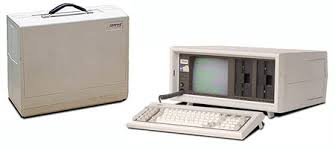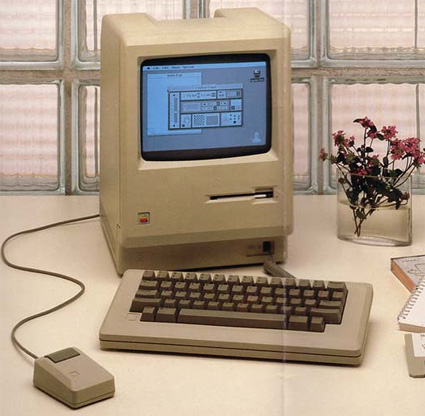The transition to digital marketing to nurture leads and measure performance got me reminiscing about the early days of technology.
 Remember this dinosaur?
Remember this dinosaur?
This was my first introduction to a “computer.” The RadioShack® TRS-80. If you’re a Gen Xer, I’m sure many of you had (or at least heard about) this computer.
My brother was already learning about “basic” in junior high and showed off his ability to make the computer calculate 1+1=2. I know, this may not sound very exciting. But at the time it was amazing, and I remember all of my cousins and siblings crowded around the monitor to see the results!

In the ’80s
I worked part-time doing data entry and word-processing on an old IBM®-PC similar to this one.
There were one or two “floppy disk” ports. The disks were thin and flimsy. They also often required YOU to load programs on it via the DOS program. Yes, you had to be a computer geek to understand how to load programs. Not only that, when using this computer, you could only use one program at a time. After all, they only held 160 kilobytes (KB) of storage, the equivalent of about 50 single-spaced, typewritten pages.
At the time, it was a fancy, but very expensive ($2,498), data entry and word-processing machine. It had a whopping 40K of ROM (read-only memory) and 16K RAM (rapid access memory) expandable to 256K RAM. Just to give you a little comparison…today’s iPhone 6 has 1G of RAM. It’s been so long since I’ve had to think about ROM, RAM and kilobytes. It makes me feel…well, old.
 Computers were not the norm for college students; typewriters were. I had the luxury of being able to use the college’s VAX or IBM-PC computer labs for projects. I remember I had to bring my “WordPerfect for DOS” floppy disk and a blank disk in order to run the software needed to do my assignments. Doesn’t the VAX system look so archaic by today’s standards?
Computers were not the norm for college students; typewriters were. I had the luxury of being able to use the college’s VAX or IBM-PC computer labs for projects. I remember I had to bring my “WordPerfect for DOS” floppy disk and a blank disk in order to run the software needed to do my assignments. Doesn’t the VAX system look so archaic by today’s standards?
Then in my junior year of college
 I got my hands on a “borrowed” Compaq Portable computer. It was as big as a large suitcase and 28 lbs. The term “portable” only meant that it was easy to fold up the keyboard, unplug the computer and stow the cord inside a compartment in the back. I thought I had it made when I was able to do my assignments in the comfort of my apartment and only had to take saved disks to the computer lab to print my files.
I got my hands on a “borrowed” Compaq Portable computer. It was as big as a large suitcase and 28 lbs. The term “portable” only meant that it was easy to fold up the keyboard, unplug the computer and stow the cord inside a compartment in the back. I thought I had it made when I was able to do my assignments in the comfort of my apartment and only had to take saved disks to the computer lab to print my files.
 This served me well until my roommate got her first Apple® computer complete with a dot matrix black an white printer. This was exciting stuff! It was the first time we’d ever used a “mouse” and were able to use some fun typefaces and graphics without needing a special code.
This served me well until my roommate got her first Apple® computer complete with a dot matrix black an white printer. This was exciting stuff! It was the first time we’d ever used a “mouse” and were able to use some fun typefaces and graphics without needing a special code.
Isn’t it cute?
By then, I was also getting a lot of exposure in my desktop publishing class. They taught us all about the available postscript and publishing software such as LaTeX and Scitex. These computers were widely used in the typesetting, publishing and printing industries. But over the course of the next 10+ years, most of these high-ticketed computer systems were quickly overtaken by the more affordable Adobe software such as Photoshop, Quark, InDesign and Illustrator, putting typesetting and prepress shops out of business.
In the late ’90s
I was on the hunt for a computer. A laptop. My very own personal computer. This is similar to what I got and what most people could afford.
It had Windows 98 and a few basic programs such as Word, Excel and Quicken. I was very excited because I now had dial-up internet access, AOL Instant Messaging and email. Remember when you had to pay a monthly fee to use AOL? I think it was $10/month. I remember the thrill of waiting to hear the sound of the computer dialing to get onto the internet.
Ah, the nostalgia!
 I had that laptop for about five-plus years before getting a regular desktop PC. It becomes fuzzy after that because by then, it was common for most people to own a computer in their home and use one at their workplace.
I had that laptop for about five-plus years before getting a regular desktop PC. It becomes fuzzy after that because by then, it was common for most people to own a computer in their home and use one at their workplace.
I was fortunate to watch the Apple to Mac computer evolution over the course of my career, but that’s another topic for another day.
Things didn’t really change as drastically for my usage like it did during my teenage years and college. I’ve gotten caught up in the wave of internet growth just like everyone else and watched the explosion of all the different software applications that have sprung up over the world.
What a long way we’ve come in such a short time!
Computer monitors continue to get thinner. Laptops are getting smaller and lighter and mostly have taken the form of tablets. Cell phones are taking over the online usage of email and social media, but I think we’ll always have a need for desktop computers, whether it be a Mac or PC.
Looking back, I don’t think I would have had nearly the appreciation of how much computer technology has changed if I didn’t experience it firsthand.
The evolution of computers moved the power of technology from the hands of an elite few into the hands of everyone — literally! Knowing that you have access to so many people, you can see how digital marketing can make a huge impact on your lead generation efforts.
It’ll be interesting to see what type of technology is invented in the next few years and its dramatic effect on digital marketing.
Check out my other “evolutionary” blog, https://www.schubertb2b.com/2016/05/the-evolution-of-b2b-lead-generation/
All marketing tactics should be thought of as part of a larger whole, rather than separate pieces. By strategically integrating all marketing tactics, the marketing program becomes more effective and cost efficient. As a B2B agency, we developed B2B 360 Integrated Digital Marketing to meet this improved performance need. To learn more about B2B 360 and how it will benefit your business, download our free eBook: The Better Path to Top-Tier Tech Marketing.
 Debbie Mackenzie is a 1991 graduate of Rochester Institute of Technology (RIT) where she majored in graphic arts production management. Deb cut her professional teeth managing production and customer relations at major printing companies before coming to Schubert b2b 13 years ago. Debbie’s a versatile big hitter overseeing all things financial and operational.
Debbie Mackenzie is a 1991 graduate of Rochester Institute of Technology (RIT) where she majored in graphic arts production management. Deb cut her professional teeth managing production and customer relations at major printing companies before coming to Schubert b2b 13 years ago. Debbie’s a versatile big hitter overseeing all things financial and operational.

